- Table of Content
- 1.ASGARD-XI
- 2.Review of sola...
- 3.Review of geom...
- 4.PROBA2 Observa...
- 5.The Internatio...
- 6.Noticeable Sol...
- 7.Geomagnetic Ob...
- 8.The SIDC space...
- 9.Review of iono...
- 10.Action!
2. Review of solar activity
3. Review of geomagnetic activity
4. PROBA2 Observations (2 May 2022 - 8 May 2022)
5. The International Sunspot Index by SILSO
6. Noticeable Solar Events (2 May 2022 - 8 May 2022)
7. Geomagnetic Observations in Belgium (2 May 2022 - 8 May 2022)
8. The SIDC space weather briefing
9. Review of ionospheric activity (2 May 2022 - 8 May 2022)
10. Action!
ASGARD-XI
ASGARD (https://eserobelgium.be/index.php/nl/asgard-balloons-for-science/ ) is an educational project that allows young people to experience space travel themselves by conducting experiments "in space". It is organised by Sint-Pieterscollege Jette together with the Belgian Space Pole institutes ROB, RMI, BISA and STCE. ESERO Belgium (European Space Education Resource Office - https://eserobelgium.be/index.php/nl/ ) promotes this project together with several other school projects that bring space exploration into schools, and supports Belgian teachers who are interested to participate.
The goal of ASGARD is to offer primary and secondary school pupils the opportunity to design, develop and build a scientific and/or technology experiment and fly it to the edge of space on a stratospheric balloon. These ASGARD balloons are flown once a year (in the March-May timeframe) and reach a maximum altitude of about 33km. The ASGARD-gondola was designed to carry a number of small educational payloads. As such, ASGARD is a unique educational tool that combines low cost (no entry fee), a short turnaround time and great flexibility to do hands-on space education in near-space conditions. The educational advantages of such a project are huge. For example, the students pass through all phases of a typical science/technology project as they have to design, develop and test their experiment themselves, fly it using a professional vehicle (the RMI weather balloons), do the data-processing, and finally report the results of the experiment.
In order to qualify for admission on board an ASGARD balloon flight, a formal project proposal has to be submitted. On the basis of these proposals, a selection is made by a jury headed by Dirk Frimout, Belgium's first astronaut. This year, which was the first edition since the start of the COVID pandemic, 20 projects were selected and distributed over 2 RMI weather balloons. Then, on the occasion of the ASGARD launch day on Thursday, April 28, 2022, about 80 students from Belgium, Spain and the United Kingdom came together for 3 days to participate in this educational project. As usual, the ROB/Planetarium (https://planetarium.be/en ) hosted the first and third day, during which the pupils had to present respectively their project and the results of the experiment to the other participants.
The main activity during the second day was obviously assembling the experiments onto the gondola, launch them with the weather balloons, and retrieve those balloons afterwards. To make this day even more interesting, workshops, visits and a meet-and-greet with other scientists were planned throughout the day. This took all place on the premises of the Space Pole. The images underneath were made by Olivier Boulvin and provide an idea on the activities carried out during launch day, with more pictures available in the online version of this news item at https://www.stce.be/news/589/welcome.html
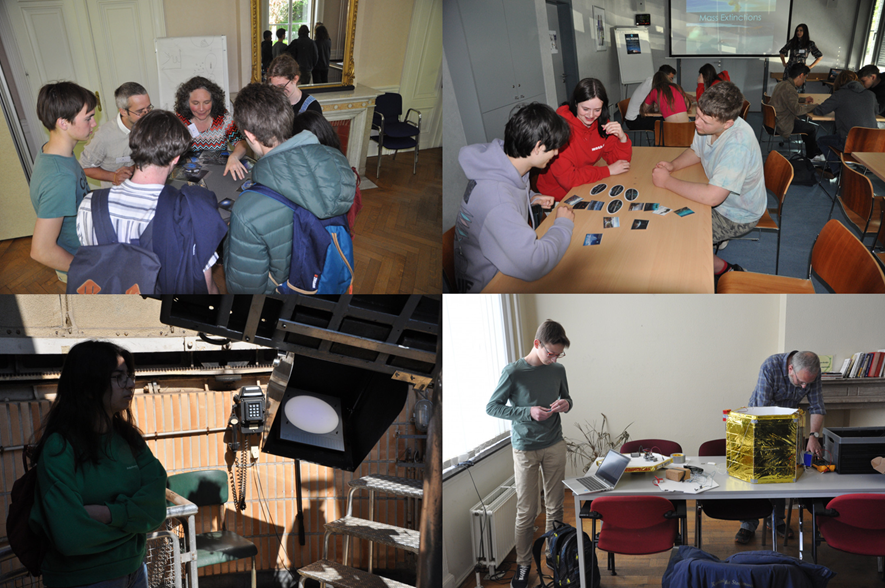
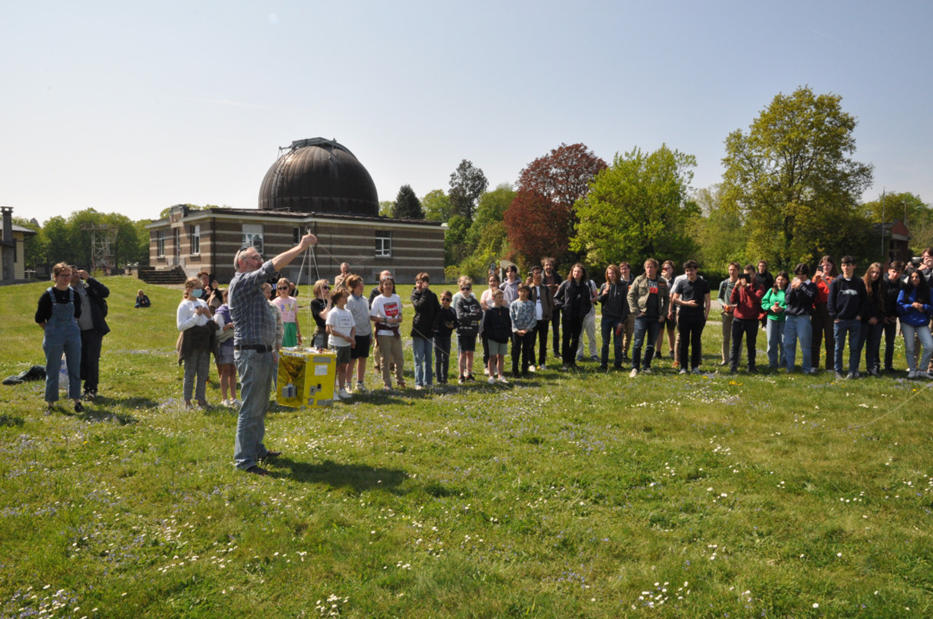
Review of solar activity
Solar flaring activity reached high levels. Nearly all the flaring activity was associated with two regions: NOAA AR 3004 and NOAA AR 3006. NOAA AR 3006 produced five M-flares and an X flare between May 03 and May 05. The X1.1 flare occurred on May 04, peaking at 13:25 UT. The X-flare and two of the M-flares originated from beyond the east limb before the region had rotated onto the solar disk and was numbered. NOAA AR 3004 began to emerge on May 02, near the central meridian and developed quickly, producing four M-class flares between May 04 and May 05. Towards the end of the week, the flaring activity decreased to low levels with both regions continuing to produce C-class flares. On May 08 a new region beyond the east limb produced a C6 flare and was later numbered as NOAA AR 3007.
There were multiple filaments present.
A dimming was observed on May 03 near the central meridian. An associated faint, slow Coronal Mass Ejections (CME) seen in LASCO-C2 on May 03 from 18:00 UT in the north east, had possibly an Earth directed component and was predicted to impact Earth on May 07.
On May 06, a filament in the north east quadrant erupted around 20:00 UT. The eruption was linked to a broad faint CME ejected to the north east. The CME came into view of LASCO C2 at 21:24 UT. The CME was considered to possibly have a glancing blow at Earth on the second half of May 10.
The greater than 10 MeV proton flux was nominal. The greater than 2MeV electron flux oscillated around the 1000 pfu threshold for most of the week. The 24h electron fluence was at normal to moderate levels.
Review of geomagnetic activity
At the start of the week the solar wind speed was near 500 km/s and gradually decreased towards a slow solar wind regime. The total magnetic field magnitude fluctuated around 5 nT, increasing to values near 9 nT on May 08. The interplanetary magnetic field phi angle was predominantly in the negative sector (directed towards the Sun).
Geomagnetic conditions were quiet on the planetary level (K NOAA 0-2). In Belgium, the geomagnetic conditions reached unsettled (K Bel 0-3).
PROBA2 Observations (2 May 2022 - 8 May 2022)
Solar Activity
Solar flare activity fluctuated from low and high during the week.
In order to view the activity of this week in more detail, we suggest to go to the following website from which all the daily (normal and difference) movies can be accessed: https://proba2.oma.be/ssa
This page also lists the recorded flaring events.
A weekly overview movie can be found here (SWAP week 632). https://proba2.oma.be/swap/data/mpg/movies/weekly_movies/weekly_movie_2022_05_02.mp4
Details about some of this week's events can be found further below.
If any of the linked movies are unavailable they can be found in the P2SC movie repository here https://proba2.oma.be/swap/data/mpg/movies/
Tuesday May 03
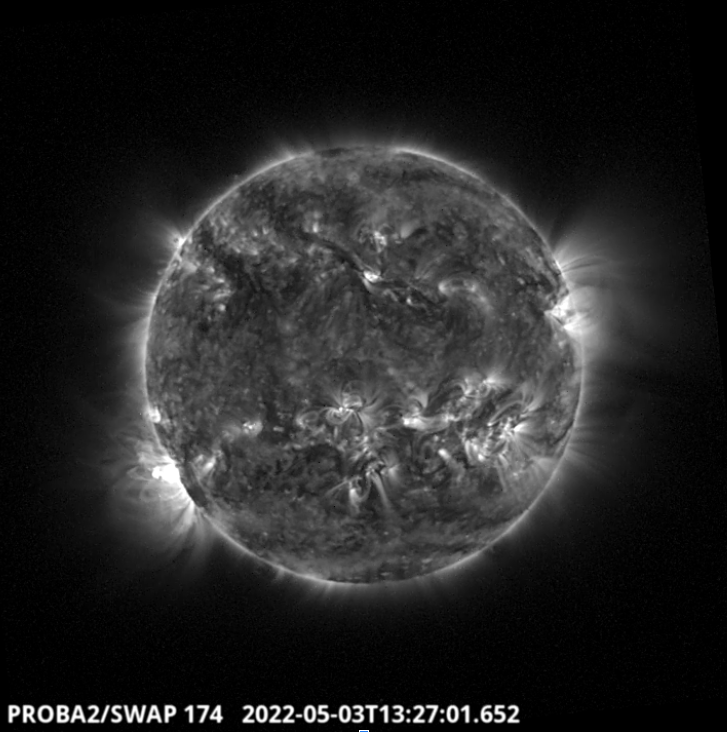
The largest flare of the week is a X1.1 flare, which took place around 13:27 UT in an active region emerging over the Sun's southeastern limb. Find a movie of the events here (SWAP movie). https://proba2.sidc.be/swap/data/mpg/movies/20220503_swap_movie.mp4
The International Sunspot Index by SILSO
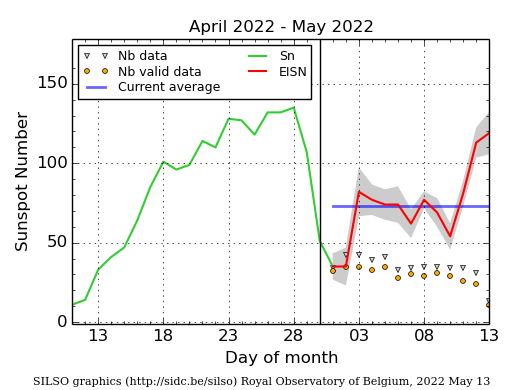
The daily Estimated International Sunspot Number (EISN, red curve with shaded error) derived by a simplified method from real-time data from the worldwide SILSO network. It extends the official Sunspot Number from the full processing of the preceding month (green line), a few days more than one solar rotation. The horizontal blue line shows the current monthly average. The yellow dots give the number of stations that provided valid data. Valid data are used to calculate the EISN. The triangle gives the number of stations providing data. When a triangle and a yellow dot coincide, it means that all the data is used to calculate the EISN of that day.
Noticeable Solar Events (2 May 2022 - 8 May 2022)
| DAY | BEGIN | MAX | END | LOC | XRAY | OP | 10CM | TYPE | Cat | NOAA |
| 03 | 0734 | 0753 | 0801 | M1.3 | III/1 | |||||
| 03 | 1309 | 1325 | 1331 | S16E5 | X1.1 | SF | 96 | 3004 | ||
| 04 | 0008 | 0019 | 0025 | M5.3 | ||||||
| 04 | 0845 | 0859 | 0910 | S16W9 | M5.7 | 1B | 32 | 96 | 3004 | |
| 04 | 1625 | 1632 | 1640 | S16W11 | M1.1 | 1N | 96 | 3004 | ||
| 04 | 1940 | 1948 | 2003 | M1.5 | 3006 | |||||
| 04 | 2009 | 2027 | 2036 | M1.6 | 96 | 3004 | ||||
| 05 | 1308 | 1316 | 1322 | S16W24 | M2.2 | SN | 96 | 3004 | ||
| 05 | 1402 | 1410 | 1414 | S29E64 | M2.7 | SF | 99 | 3006 |
| LOC: approximate heliographic location | TYPE: radio burst type |
| XRAY: X-ray flare class | Cat: Catania sunspot group number |
| OP: optical flare class | NOAA: NOAA active region number |
| 10CM: peak 10 cm radio flux |
Geomagnetic Observations in Belgium (2 May 2022 - 8 May 2022)
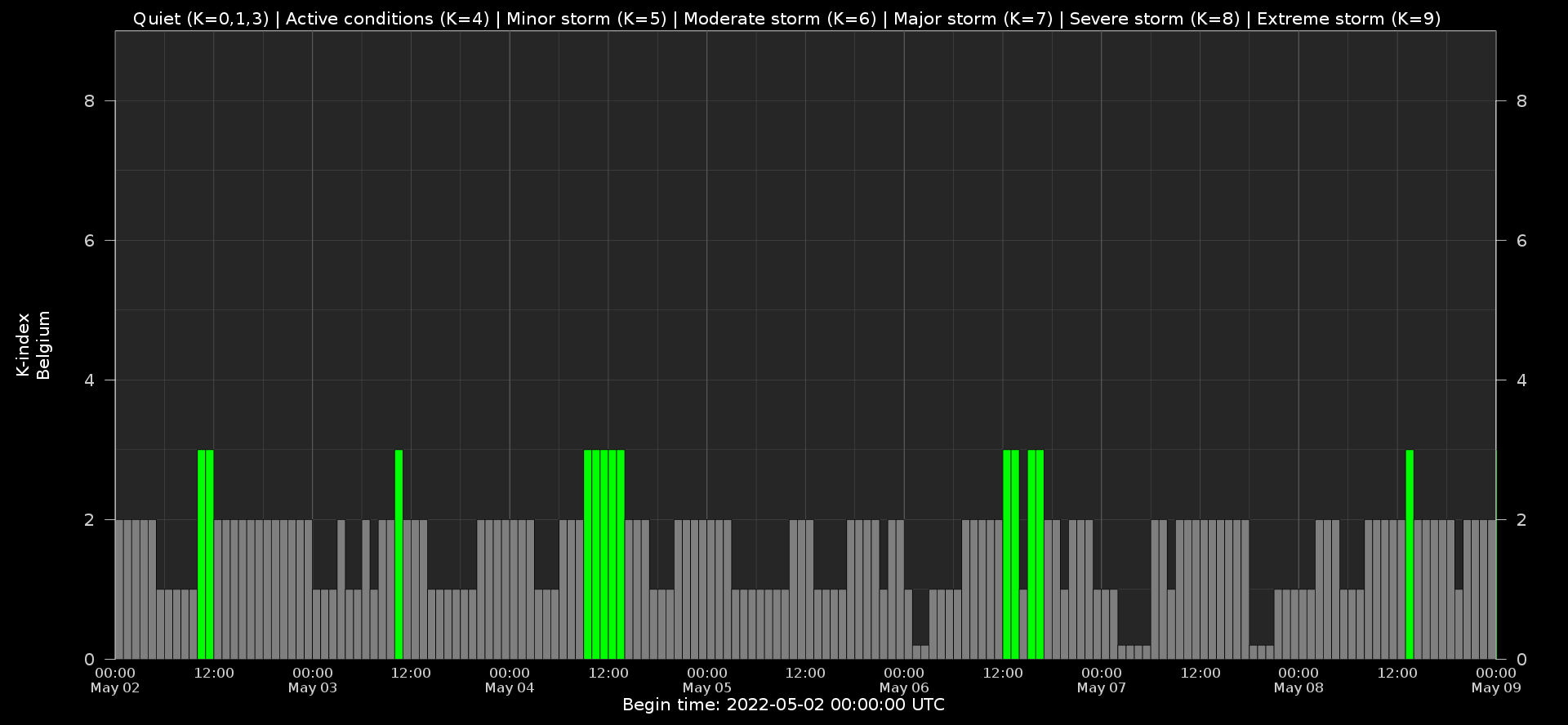
Local K-type magnetic activity index for Belgium based on data from Dourbes (DOU) and Manhay (MAB). Comparing the data from both measurement stations allows to reliably remove outliers from the magnetic data. At the same time the operational service availability is improved: whenever data from one observatory is not available, the single-station index obtained from the other can be used as a fallback system.
Both the two-station index and the single station indices are available here: http://ionosphere.meteo.be/geomagnetism/K_BEL/
The SIDC space weather briefing
The Space Weather Briefing presented by the forecaster on duty from May 2 to 8. It reflects in images and graphs what is written in the Solar and Geomagnetic Activity report: https://www.stce.be/briefings/20220509_SWbriefing.pdf
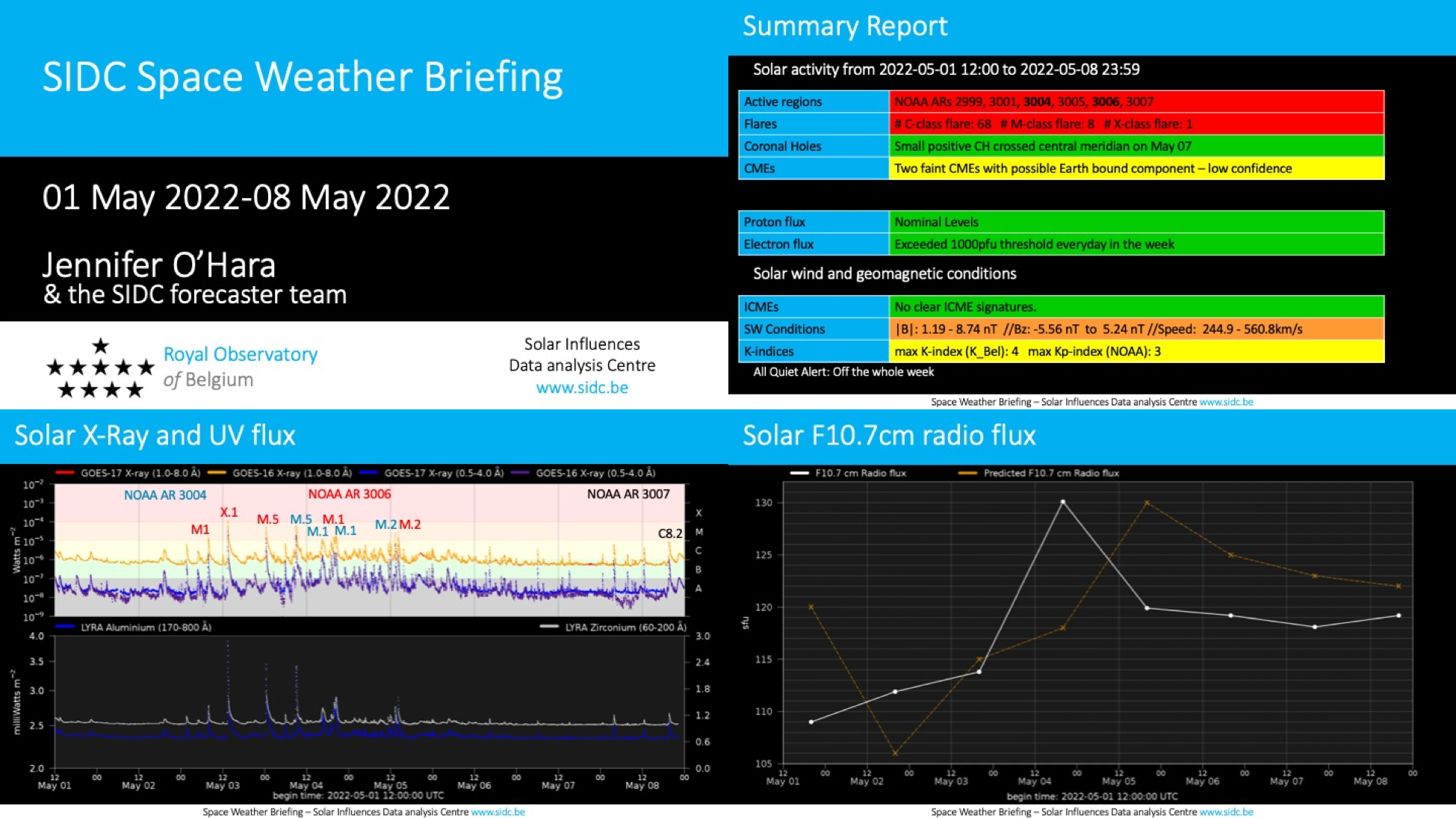
Review of ionospheric activity (2 May 2022 - 8 May 2022)
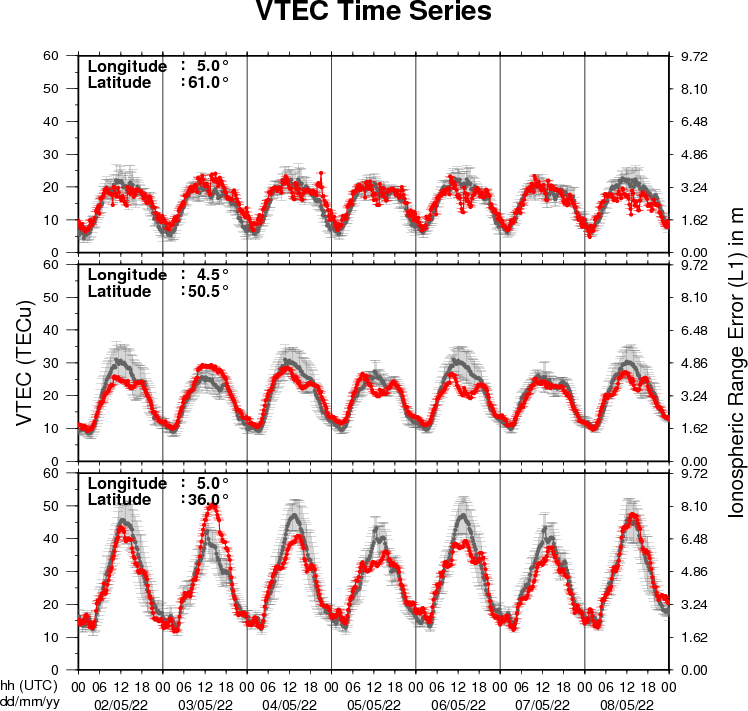
The figure shows the time evolution of the Vertical Total Electron Content (VTEC) (in red) during the last week at three locations:
a) in the northern part of Europe(N 61deg E 5deg)
b) above Brussels(N 50.5deg, E 4.5 deg)
c) in the southern part of Europe(N 36 deg, E 5deg)
This figure also shows (in grey) the normal ionospheric behaviour expected based on the median VTEC from the 15 previous days.
The VTEC is expressed in TECu (with TECu=10^16 electrons per square meter) and is directly related to the signal propagation delay due to the ionosphere (in figure: delay on GPS L1 frequency).
The Sun's radiation ionizes the Earth's upper atmosphere, the ionosphere, located from about 60km to 1000km above the Earth's surface.The ionization process in the ionosphere produces ions and free electrons. These electrons perturb the propagation of the GNSS (Global Navigation Satellite System) signals by inducing a so-called ionospheric delay.
See http://stce.be/newsletter/GNSS_final.pdf for some more explanations ; for detailed information, see http://gnss.be/ionosphere_tutorial.php
Action!
Check out our activity calendar: activities and encounters with the Sun-Space-Earth system and Space Weather as the main theme. We provide occasions to get submerged in our world through educational, informative and instructive activities.
If you want your event in our calendar, contact us: stce_coordination at stce.be
* May 12, KU Leuven/ CmPA Seminar: Dynamical evolution and oscillation of highly magnetised compact objects
* May 17, ROB Seminar: Teaching and learning astronomy and astrophysics in a planetarium – Open Call for collaboration with scientists of the Space Pole
* May 19, KU Leuven/ CmPA Seminar: Of coronas and coconuts - The COCONUT solver for global coronal modelling
* June 9, Public Lecture, Noorderlicht - hemelse wetenschap, Molenhof, Leuven, Belgium
* June 13-15, Space Weather Introductory Course - onsite, by the STCE, Brussels, Belgium
* June 25, STCE at the Summer Space Festival
* July 3, Public Lecture on STCE's mission to the Sun, Cosmodrome, Genk, Belgium
* August 25, Public Lecture on Space Weather and Aviation, Astropolis, Oostende, Belgium
* October 24-28, 18th European Space Weather Week, Zagreb, Croatia
* November 21-23, Space Weather Introductory Course - onsite, by the STCE, Brussels, Belgium
* December 5, 6, 8, 9, Space Weather Introductory Course - online, by the STCE, zoom
Check: https://www.stce.be/calendar
